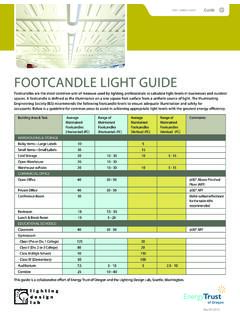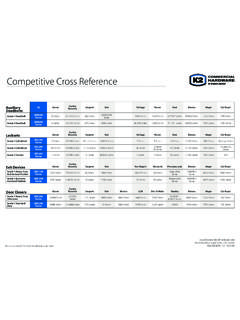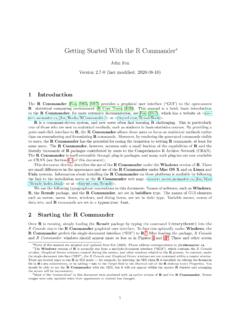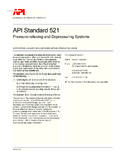Transcription of THE BASICS of LEDs - Lighting Design Lab
1 1 THE BASICS of LEDs DEVELOPED BY: Eric Strandberg, LC & Jeff Robbins, LC, MIES PRESENTED BY: Jeff Robbins Fall, 2012 2 Lighting Design LAB A Northwest utility funded Lighting education facility promoting commercial and industrial energy conservation. 3 OUR FACILITY 4 OUR FACILITY 5 OUR SERVICES Lighting Classes (local and regional) Demonstration Area LDL LED Qualified Products List Lighting Consultations Website Resources Outdoor Lighting Center Technical Information Product Evaluations Mock-Up Facility Lighting Library Tours of Facility Newsletter Lighting Guides General Information 6 WEBSITE 7 CONTENT OUTLINE Part 1: The BASICS Diode Defined LED Defined A Brief History Advantages How they Work Lamp Anatomy How They Produce Colors How They Produce White light Fixture Anatomy Part 2.
2 Details Light Output of Light Efficacy Power Consumption Factor Management Life and Powering to Ask and Terminology 8 Part 1: THE BASICS Diode Defined In electronics, a diode is a component that restricts the direction of movement of charge carriers. Essentially, it allows an electric current to flow in one direction. In simple terms, a switch. 9 LED Defined A Light Emitting Diode is a semiconductor device that emits visible light of a certain color, and is fundamentally different from conventional light sources such as incandescent, fluorescent, and gas-discharge lamps, in that an LED: uses no gas or filament, has no glass bulb, and no failure-prone moving parts.
3 10 A Brief History In 1962 the first red LED was developed by Nick Holonyak at Throughout the 60 s red LEDs were ued as small indicator lights on electronic devices . Green and yellow LEDs were introduced in the early 70 s, and were used in electronics, traffic signals, exit signs, and watches, etc. 11 A Brief History, (cont.) By 1990, LEDs of one lumen output were available. In 1993, Shuji Nakamura at Nichia created the first high-brightness blue LED, making it possible to RGB mix to any color. This was followed in 1996 by the development of Phosphor White LEDs, which combined a blue or ultraviolet LED with a phosphor coating that produced white light.
4 12 A Brief History, (cont.) By 2005, output levels of 100 lumens were possible. white light LEDs became available in various shades. LEDs began competing with conventional light sources and fixtures in general illumination applications. The Department of Energy expects LED technology to become the preferred method of Lighting in homes and offices by 2025. 13 Advantages Comparable in efficacy to CFLs, gaining on fluorescent tubes, and incandescents. Fixtures are directional, allowing for more efficient optics. Quality of White Light LEDs now comparable to CFLs, recent advances assure better consistency in color and CCT.
5 Significantly longer Useful life. 14 Advantages (cont.) Light output has improved by 35% / year, while cost has dropped by 20% / year No infrared, (IR) radiation No ultraviolet, (UV) rays Mercury free Can operate in cold environments Can withstand impact and vibrations Inherently digital for ease of control Instant on Growing trend to modularity 15 0 How They Work Like a normal diode, the LED consists of a chip of semiconducting material impregnated, or doped with impurities to create a p-n, (positive / negative) junction. Atoms in the n-type material have extra electrons, atoms in the p-type material have electron holes.
6 16 How They Work (cont.) Applying current pushes the atoms toward the junction. When they get close, the n-type atoms donate their extra electrons to the p-type atoms which accept them. A negative charge to the n-side allows current to flow from the (-) charged area to the (+) charged area. This is called forward bias . CURRENT 17 How They Work (cont.) When extra electrons in the n-type material fall into the holes in the p-type material, they release energy in the form of photons. The material in an LED is selected so that the wavelength of the photons falls within the visible portion of spectrum. Different materials produce photons at different wavelengths / color.
7 18 Lamp Anatomy, Indicator-Type Typically 5mm Usually inexpensive Low Power Generated heat dissipated internally Used only in: Panel Displays Electronic devices Instrument Illumination 19 Lamp Anatomy, Illuminator-Type AKA surface-mount LEDs High Brightness LEDs Durable, high-power devices Capable of providing: Functional illumination Light output equal to, or surpassing many conventional sources 20 Lamp Anatomy, Illuminator-Type (cont.) All Illuminator-Type LEDs share the same basic architecture: A semiconductor chip, (or die) A substrate that supports the chip Contacts to apply power Bond wire to connect the contacts to the chip Heat sink plus surface-mount solder connections provide a thermally conductive path Lens Outer casing 21 LEDs produce different colors by using different material systems, each system producing photons of different wavelengths.
8 Illuminator-Type LEDs use systems which can handle the necessary heat, current, and humidity to produce high-brightness red and amber, (Alln-GaP), and high-brightness blue, green and cyan, (InGaN). Alln-GaP and InGan cover almost the entire spectrum. A gap occurs in the yellow-green portion, which can be filled by including different color LEDs in the same device. How They Produce Colors 22 How They Produce Colors (cont.) An LED can: Only emit the one color that the specific composition of its materials can produce. Combine red, green and blue in a single device. Create millions of colors by controlling the relative intensity of each color.
9 Use the additive RGB color mixing process. (The subtractive color mixing refers to pigments.) 23 How They Produce Colors (cont.) The Color Space chart defines the gamut of visible colors. The gamut of colors an LED fixture can produce depends on the specific colors of the red, green, and blue LEDs used in the fixture or chip. In theory a tricolor device can reproduce any color within the gamut. 24 How They Produce White Light Method 1 RGB mixing (previously covered) Better control over exact color. Is hardware intensive / expensive Tends to make pastels look unnatural, hence poor CRI 25 How They Produce White Light (cont.)
10 Method 2 Phosphor White (Remote Phosphor) Produces white light in a single LED by combining a short wavelength LED, (blue), and a yellow phosphor coating. The blue photons either pass through the phosphor layer without alteration or are converted into yellow photons in the phosphor layer. The combination of blue and yellow photons produce a bluish White light with better CRI, and is more efficient than RGB. 26 Fixture Anatomy To be used for illumination, LEDs must be integrated into systems that incorporate: Optics Reflector cups, lensing and aiming features Drivers Microprocessor-based power management, and control stages Power Supplies voltage conversion units Thermal Management vents and heat sinks Well designed fixtures integrate all these features into the fixture itself.









